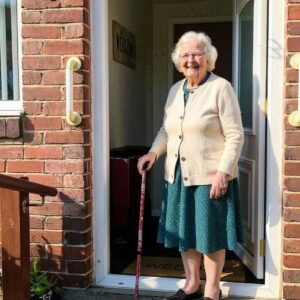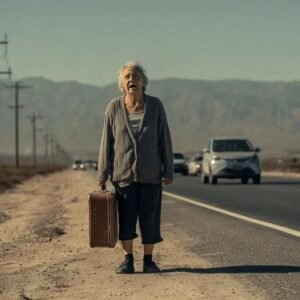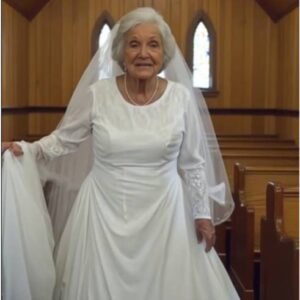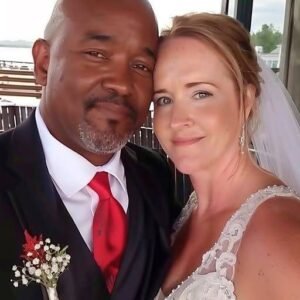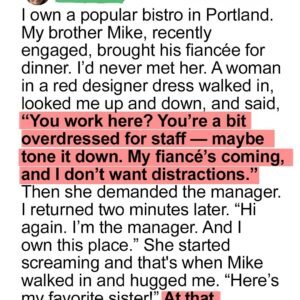It was the kind of summer day where the air felt heavy, like it was pressing down on everything. The streets were nearly deserted, the pavement shimmering under the sun, and the parking lot outside Maplewood Shopping Plaza sat in eerie silence.
Lucas Reynolds, 23, had just wrapped up another long shift at a small electronics repair shop on the outskirts of town. Between full-time work and night classes in computer engineering, his days followed a strict routine: work, school, home, repeat.
As he crossed the baking hot parking lot with his bag slung over one shoulder, something made him pause—a faint sound, barely audible over the heat. A low whimper.
Lucas stopped and scanned the lot. Again, a faint cry.
Following the sound, he approached a black SUV parked in a distant corner. The windows were tinted, but as he got closer, he could make out a small figure slumped in a car seat.
A child.
His heart jumped. Pressing his face to the glass, Lucas saw a toddler—no more than a year old—strapped into the seat. The child’s cheeks were flushed, lips cracked, and tiny chest rising in shallow breaths. Too weak to cry, the boy was clearly in trouble.
Lucas pounded on the window. “Hey! Can you hear me?” No response. He tugged the door handle—it was locked.
The lot was empty. No parent in sight. Just the sun, and a child slowly cooking in a metal oven.
Lucas dialed 911, but as he glanced at the boy’s fluttering eyelids, he realized he didn’t have time to wait.
“I’m sorry, little guy,” he muttered, grabbing a large landscaping rock from a nearby flowerbed. With a single blow, he shattered the rear window. Carefully avoiding the glass, he reached in and unbuckled the child. The baby’s skin was alarmingly hot.
Clutching him close, Lucas ran as fast as he could to a nearby urgent care clinic. The boy whimpered against his chest.
Bursting through the clinic doors, Lucas shouted, “Help! A baby was trapped in a hot car—he’s overheated!”
The staff sprang into action, taking the child from his arms and rushing him into treatment. Lucas collapsed into a waiting room chair, trembling and soaked in sweat. A receptionist handed him a tissue—he hadn’t realized he was crying.
“You did the right thing,” she said softly.
Fifteen tense minutes passed before a nurse returned with an update. The child had been severely dehydrated and close to heatstroke, but they’d stabilized him. A few more minutes could’ve ended in tragedy.
Lucas exhaled deeply, relief washing over him.
Then, chaos erupted.
A woman in her early 30s stormed into the clinic, her face twisted with anger. “Where’s my son?!”
A nurse brought her to the treatment area, but moments later, she returned—heading straight for Lucas.
“You! You broke my window!” she shouted.
Lucas tried to explain. “Ma’am, your child—he was—”
“I was gone for five minutes!” she snapped. “You had no right! I’m calling the police!”
The waiting room fell silent.
Lucas stared in disbelief. He’d expected gratitude, maybe even a hug. Instead, she saw only a broken window—not the life he might have saved.
A nurse intervened, “Ma’am, your son was in serious danger. This young man likely saved his life.”
But the woman, later identified as Karen Ellis, was already on the phone, reporting a “young man who vandalized her car and touched her child.”
Police arrived within minutes.
Officer Grant approached Lucas calmly and asked him to explain. Lucas walked him through the entire situation—from the faint cries to the shattered glass, to the urgent rush to the clinic.
The officer nodded and spoke with the medical staff, who confirmed that the child had been on the verge of heatstroke. Lucas’s actions had likely prevented a medical emergency.
Then they spoke to Karen.
“Ma’am,” Officer Grant said, “leaving a child alone in a locked car, especially in this heat, is extremely dangerous. You’re lucky someone acted quickly.”
Karen tried to defend herself. “I was just in the pharmacy! It was only a few minutes!”
“You may still face child endangerment charges,” the officer replied. “We’re required to report this. For now, focus on your son.”
Karen was issued a warning and required to attend parenting classes and complete community service. Her son fully recovered.
Meanwhile, Lucas stood quietly, unsure whether he felt vindicated or just numb.
Before leaving, the officers shook his hand. “You did the right thing,” Officer Grant said. “Most people would’ve walked away. You didn’t.”
Lucas didn’t want praise. He just shrugged. “I couldn’t walk away.”
What he didn’t know was that someone had captured a photo of him outside the clinic, cradling the child in his arms. That image—Lucas, drenched in sweat, holding the limp toddler—was shared online with the caption:
“This man broke a window to save a baby from a hot car today. The mother screamed about her glass while he stayed calm and held the child. A true hero.”
The photo went viral.
Local news picked it up. Social media exploded with messages of support, admiration, and gratitude. Lucas, however, ignored most of it. The attention felt strange and undeserved.
Then one evening, someone knocked at his door. A man in a suit handed him a small box.
“Mr. Reynolds? I’m with the Hawkins Child Safety Foundation. We’d like to honor you with our Community Hero Award.”
Lucas hesitated. “I didn’t do it for recognition.”
The man smiled. “That’s exactly why you deserve it.”
In the days that followed, Lucas reluctantly agreed to speak at a local elementary school about safety, kindness, and doing the right thing—even when it’s hard.
“I saw someone who needed help,” he told a room full of kids. “So I helped. That’s it.”
One child asked, “Were you scared?”
Lucas smiled. “Yes. But being scared doesn’t mean you don’t act. Sometimes, you just have to.”
Sometime later, he received a short, handwritten note from Karen:
I made a terrible mistake. Thank you for saving my son.
He tucked the letter in a drawer and never looked at it again. For Lucas, it wasn’t about awards or apologies.
He heard a child’s faint cry in the silence of a summer afternoon—and he answered.
And for him, that was enough.
